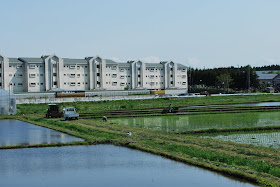
I saw this bag and was shocked with the price, so I grabbed my cell cam and took this photo :-)
The actual price of this school bag is 40,000 yen or $400+ with 5000 yen discount, so it's around $350 now but still expensive

These 2 bags are a bit cheaper than the first bag above, 13, 860 yen or $140. I think the price varies depending on the material some would cost as high as $850

I always notice the school bags of students here are uniform....WHY???

The two boys have different colors of backpack but the same style....WHY???
-------------------------------------------------------------------------------------------
After my keen observation and curiosity about this unusual backpack of Japanese students, I have to do something that will answer my queries hehehe..... so I searched google and found out that this backpack is called
randoseru, and is used by elementary students.
According to wikipedia:
Randoseru-
randoseru (ランドセル?) is a firm-sided
backpack made of stitched firm
leather or leather-like synthetic material, most commonly used in
Japan by
elementary schoolchildren. It measures roughly 30 cm high by 23 cm wide by 18 cm deep, and features a softer grade of leather or material on those surfaces which touch the body. When empty, the average
randoseru weighs approximately 1.2 kilograms (about 2 1/2 pounds avoirdupois). The term
randoseru is a borrowed word from the
Dutch "ransel" meaning "backpack", a clue to its origins nearly 200 years ago as used in the
Netherlands.
The
randoseru is the most universal and recognizable feature of the
Japanese school uniform and is considered symbolic of the virtues necessary to obtain a good
education—unity, discipline, hard work and dedication. Traditionally, the
randoseru is red in colour for girls, black for boys.
[2] While in more conservative schools the colour (and often the brand and design) is mandated and enforced, the backpack is available in a variety of colours, partly as a compromise for parents to retain some tradition within modernized schools which no longer require the use of traditional uniforms or of the
randoseru.
Traditionally given to a child upon beginning their first year at school, the
randoseru's materials and workmanship are designed to allow the backpack to endure the child's entire elementary education (six years). However, the care usually given to the
randoseru throughout that time and afterwards can extend its life and preserve it in near-immaculate condition long after the child has reached adulthood, a testament to its utility as an accessory and the sentiment attached to it by many Japanese as symbolic of their relatively carefree childhood years.
The
randoseru's durability and significance is reflected in its cost: a new
randoseru made of genuine leather can carry a pricetag of over 30,000
yen, almost 300 US dollars, as May 2008 exchange rate.
Clarino, a synthetic material frequently used as a substitute, reduces the cost somewhat. Often
randoseru are available on auction sites, in new or used condition, at much lower prices, particularly after the start of the Japanese school year in April.
-------------------------------------------------------------------------------------
Still expensive for me :-)



 Finally, rice were planted!!!
Finally, rice were planted!!!






























